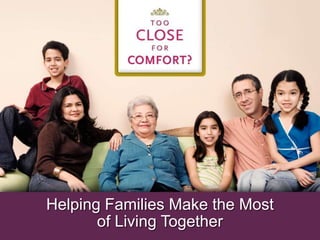
His 0987 Too Close For Comfort
- 1. Helping Families Make the Mostof Living Together
- 2. A Growing National Trend According to a recent survey conducted for Home Instead Senior Care, 43 percent of adult caregivers in the U.S. live with the person they’re caring for.1 The Census Bureau confirms this trend: A roughly 60 percent increase in seniors living with their adult children between 2000 and 2007.2-3 Sources: 1. Survey Methodology:The Boomer Project (www.boomerproject.com) completed online interviews with 1,279 U.S. adult caregivers, ages 35-62, with a parent, step parent or older relative who they or someone in their household cares for. Of the 1,279 family caregivers interviewed, 548 live with the senior receiving care. 2. U.S. Census Bureau; online at http://factfinder.census.gov/servlet/DTTable?_bm=y&-geo_id=01000US&-ds_name=DEC_2000_SF1_U&-_lang=en&-redoLog=false&-mt_name=DEC_2000_SF1_U_P027&-format=&-CONTEXT=dt 3. U.S. Census Bureau; online at http://factfinder.census.gov/servlet/DTTable?_bm=y&-geo_id=01000US&-ds_name=ACS_2007_1YR_G00_&-_lang=en&-mt_name=ACS_2007_1YR_G2000_B09016&-format=&-CONTEXT=dt
- 3. Factors Driving the Trend Following are the factors driving this trend: Families may be required to share caregiving duties. Seniors feel the need for physical or emotional support if they lose a spouse, experience health issues or have problems maintaining their property. The economy is affecting the financial outlook of seniors living on fixed incomes.
- 4. A Public Education Campaign This campaign will help adult children begin to address issues of living under one roof. Our experts: Matthew Kaplan, a Penn State Intergenerational Programs extension specialist Adriane Berg, a boomer consultant and author Dan Bawden, founder of the CAPS (Certified Aging in Place Specialists) program for the National Association of Home Builders (NAHB)
- 5. Valuable Resources A guide of tips on the emotional, physical and financial aspects of intergenerational living A Web site (www.makewayformom.com) provides additional support and information including a calculator A virtual tour of an intergenerational home
- 6. Important Questions The issues of caregiving are at the heart of whether families should decide to move in together, according to our expert from Penn State. Do we have the resources in terms of time andknow how? What contributions can family members make in caring and supporting others? Go over the options and discuss the pros and cons. Ask yourself, “Can I get the whole family behind the idea?” When a decision to combine families is made, expectations should be discussed and negotiatedright away.
- 7. Tips for Families Take a family partnership perspective Set expectations right away Ask for help Make family unity key
- 8. Tips for Families (continued) Find threads of common interest to build a bridge between the generations Keep lines of communication open Distinguish between private space and shared space
- 9. Safe Haven or Parent Trap? Lower the peephole Install outside shelves Combine kitchen faucet and hose Install commercial carpet Create attic storage
- 10. Financial Freedom or Household Headaches? Compute the costs Share but beware Keep money separate Consider caregiving costs What about deductions?
- 11. If you’d like to learn more about our services, or if you’re interested in employment as a Home Instead CAREGiverSM, please contact my office – a local, independently owned and operated Home Instead Senior Care® franchise. Questions and Answers